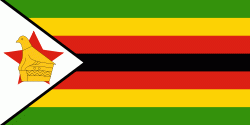Gokwe centre (Gokwe)
Gokwe Centre is a rural town in the Midlands province in Zimbabwe. The town is usually referred to as "Gokwe Centre" because the larger region is called Gokwe.
Gokwe was originally a government station. It housed a district commissioner, police, hospital, veterinary services and other government rural agencies. Primarily for the administration of the district, it was also the base for the control of the tsetse fly and its associated lethal disease trypanosomiasis (sleeping sickness).
Gokwe was originally a government station. It housed a district commissioner, police, hospital, veterinary services and other government rural agencies. Primarily for the administration of the district, it was also the base for the control of the tsetse fly and its associated lethal disease trypanosomiasis (sleeping sickness).
Map - Gokwe centre (Gokwe)
Map
Country - Zimbabwe
 |
 |
| Flag of Zimbabwe | |
The British South Africa Company of Cecil Rhodes demarcated the Rhodesia region in 1890 when they conquered Mashonaland and later in 1893 Matabeleland after a fierce resistance by Matabele people known as the First Matabele War. Company rule ended in 1923 with the establishment of Southern Rhodesia as a self-governing British colony. In 1965, the white minority government unilaterally declared independence as Rhodesia. The state endured international isolation and a 15-year guerrilla war with black nationalist forces; this culminated in a peace agreement that established universal enfranchisement and de jure sovereignty as Zimbabwe in April 1980. Zimbabwe then joined the Commonwealth of Nations, from which it was suspended in 2002 for breaches of international law by its government under Robert Mugabe and from which it withdrew in December 2003.
Currency / Language
| ISO | Currency | Symbol | Significant figures |
|---|---|---|---|
| ZWL | Zimbabwean dollar | 2 |
| ISO | Language |
|---|---|
| SN | Shona language |















